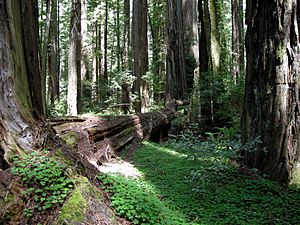Bull Creek (Humboldt County) facts for kids
Quick facts for kids Bull Creek |
|
|---|---|

Old-growth redwood forest of the Bull Creek floodplain
|
|
| Country | United States |
| State | California |
| Region | Humboldt County |
| Physical characteristics | |
| Main source | 40°15′36″N 123°59′15″W / 40.26000°N 123.98750°W |
| River mouth | South Fork Eel River 272 ft (83 m) 40°20′57″N 124°00′04″W / 40.34917°N 124.00111°W |
| Basin features | |
| Basin size | 41 sq mi (110 km2) |
Bull Creek is a large stream in California. It flows into the Eel River. The entire area that drains into Bull Creek is protected. It's part of the amazing Humboldt Redwoods State Park.
This area is special because it has the world's biggest unbroken forest of ancient coast redwood trees. Bull Creek winds in a big curve around Grasshopper Mountain, which is 3,373 feet (1,028 meters) tall. It then joins the South Fork Eel River. This meeting point is about 1.5 miles (2.5 km) upstream from where the South Fork joins the main Eel River.
Contents
Amazing Redwood Forests
The flat areas along Bull Creek are home to an incredible forest. This forest has more living material (like trees and plants) than any other forest on Earth!
The World's Tallest Trees
The tops of these trees also form the world's highest "canopy." The canopy is like the leafy roof of the forest. This means the average height of the grown-up trees here is taller than anywhere else.
On average, the trees in this forest are over 300 feet (91 meters) tall. Some trees are even taller than 360 feet (110 meters)! Most of the trees forming this tall canopy are very old coast redwoods. Many of them are over 1,000 years old.
You can also find other trees like Tanoak, California laurel, and Douglas fir near the creek. Because the tree canopy is so thick, not much sunlight reaches the ground. The ground is mostly covered by a plant called Redwood sorrel. This plant can grow well in the shade.
Famous Giant Trees
The Bull Creek forest is home to some of the world's biggest and tallest trees. One famous tree is the Stratosphere Giant. It was known as the tallest tree in the world from 2000 to 2006. Another huge tree here is the Bull Creek Giant. It is the largest tree in all of Humboldt Redwoods State Park.
History of Protection
Protecting these amazing forests is very important. Early efforts focused on saving single redwood trees or small groups. But people soon realized that all parts of a forest ecosystem work together. This includes the plants and animals living in the streams nearby.
Why the Whole Area Matters
To keep the giant redwoods healthy, the entire Bull Creek area is protected. This helps prevent changes to the water quality upstream. Good water quality is vital for the creatures living in the streams. It also helps the trees in the flat areas where the biggest redwoods grow.
Redwood trees help control how much the soil washes away, which is called erosion. When large redwood trees fall, their trunks are very strong and don't rot easily. They can help stop erosion better than the soft rocks in the area.
Saving the Redwoods
The Founders Grove, located on the Bull Creek flat, was part of a 9,400-acre (3,800-hectare) area bought in 1931. This purchase was made by the Save the Redwoods League.
However, in 1947, trees on the slopes above Founders Grove were cut down. Then, in December 1955, very heavy rains caused a big flood. Soil, rocks, and debris washed down from the deforested slopes. This flood knocked down 300 large trees in the grove. These trees had trunks wider than 4 feet (1.2 meters).
Even more trees were lost during the Christmas flood of 1964. After these floods, the Save-the-Redwoods League bought most of the remaining land in the Bull Creek area. This was done to make sure the forests on the slopes would be managed in a way that protects the entire ecosystem, similar to how nature works.

